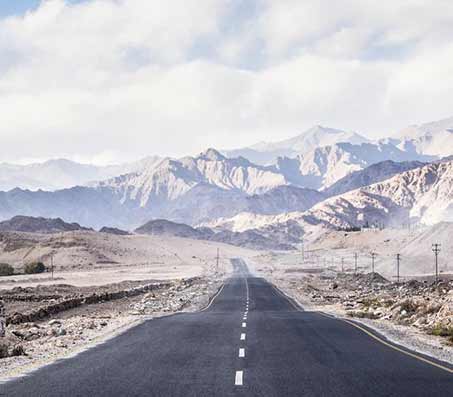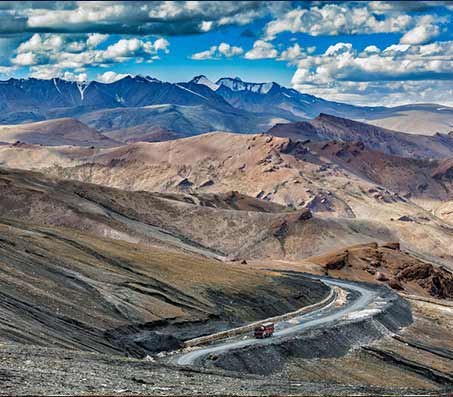Accommodation: Throughout the entire tour you will stay in the hotels where you can relax and enjoy quality services.
Transportation: Exclusive non AC vehicle will be provided for the entire tour.
Guide Service: A well experienced guide will be available to assist you during your tour.
Wonderful Memories: At the end of your tour you will take back a huge bundle of beautiful memories that you will cherish for lifetime.
Arrive in Leh on your own. You will be transferred to the hotel. Check in to the hotel and spend the whole day getting acclimated to the altitude of 11500 feet. Overnight stay at the hotel.
Rise and shine with the view of beautiful sunrise of Ladakh valley. After breakfast, leave for sightseeing around Leh. Explore the Leh monastery; visit the most beautiful monastery in Ladakh – Thiksey Gompa. Stroll around one of the most famous and largest monasteries of Ladakh – Hemis Gompa. Have your hot lunch on the way. In the evening visit the magnificent Shanti Stupa and spend some time admiring the beauty of Ladakh with the stunning sunset. Later return to the hotel and have your dinner. Overnight stay at the hotel.
Relish your breakfast early morning and check out from the hotel. Drive to Zingchen, which will take an hour from Leh. Start your trek today from Zingchen to Rumbak valley. The trail from Zingchen to Rumbak Valley is a gradual ascent. Rumbak valley is the home to the Snow Leopard. You will get a chance to interact with the locals and get to know more about their culture and lifestyle. Overnight stay at the camps.
Search for the majestic Snow Leopard starts today. After breakfast, start trekking to Stok La. Climb up to the pass and get stunning views of the Indus Valley. Follow the footprints and trails of Snow Leopard, if you get lucky on the first day, you might spot one. Other animals like blue sheep, Ibex, Tibetan sheep (Argali), red fox & Lynx can be spotted. Return to the camp by evening. Overnight stay at the camps
Explore Rumbak valley and look for signs of Snow Leopard. Spend another day with the Guide and trained naturalists on the look-out for Snow Leopard and its prey. Snow leopards are the wild predators of cold deserts that love to live in isolation; they descend to lower regions in the winter season or when there is a heavy snowfall. If you have cameras, night visions are recommended as you might spot one in the night. Overnight stay at the camps.
You have the entire day to yourself in the valley. Spend the day at leisure, exploring the forest and the valley. Wander through the beautiful valley and take some amazing shots of the Hemis National Park and its wildlife. You can visit the nearby villages and get to know more about the culture and traditions of Ladakh. Overnight stay will be at the camps.
Drive back to Zingchen to reach Likir. Enroute visit some of the famous spots in Ladakh. Admire the views from Spituk monastery, which has backdrop of Indus River and snowcapped peaks of the Himalayas. The monastery currently is home to 100 monks. Visit Gurudwara Pathar Sahib, where it’s said that Sikh Guru Guru Nanak Dev vanquished a demon. Visit the famous Magnetic Hill, which defies the laws of gravity. Overnight stay at the campsite in Likir.
Start your journey from Likir back to Leh. Enroute stop for some traditional Ladakhi tea with a local family. Enjoy the evening at the hotel with bonfire and gaze at the beautiful night sky of Ladakh. Overnight stay at the hotel.
In the morning you will be transferred to the airport for your onwards journey. Your adventurous Snow Leopard trek concludes today.
For travelling to Leh, tourists do not require any permit. However, registration is needed for all foreigners and international tourists, especially those travelling by road. Registration can be done at Drass, Rumtse and Sarchu. Those travelling by air should get their registration done at the airport.
Tourists are required to obtain a Protect Area Permit for visiting restricted areas including Tso Moriri, Tso Kar, Pangong Tso Lake, Dhahanu and Nubra Valley. One can obtain these permits through registered travel agencies. While travelling, it’s advisable to multiple copies of valid ID and permits as these are required to be submitted at the checking points.
Altitude sickness or acute mountain sickness is common when you travel to Ladakh. It’s caused by exposure to lower percentage of oxygen at high latitudes. As a general rule, rest for a day or two after every climb of 2,000ft of climb above 8000ft. This will give your body plenty of time for acclimatization. You should avoid smoking and consuming alcohol. One should carry medicines for basic medical conditions like fever, stomach ache, headache and others.
If you have plans to visit some interior areas like Turtuk, Panamik, Khaltse, Pangong, Changthang, Hunder, TsoKar and TsoMoriri etc. in Ladakh City even Indian residents need to obtain innerline permits.
Overseas travelers (with the exception of residents of Burma, Bhutan, Nepal and Pakistan) need to obtain Protected Area Permit (PAP) to visit the above places. In case of foreigners, the permit is issued only for a group with four or more foreign tourists. For foreign tourists, it is also mandatory to go through a registered travel agent in order to obtain the Permit.
Avoid using plastic bags: Both locals and tourists have a responsibility towards maintaining the environment hence, do not litter around the place. Plastics are officially banned in Ladakh and hence it is better to avoid using polythene bags
Carry proper documents: Always carry all your travel documents, permits, licenses, identity cards etc. There are lots of passes like Changla Pass, Zojila Pass, Fatula Pass and Khardungla Pass where they have a huge military presence. Make sure to make copies of all the documents and IDs and keep them safely in your bag since you may never know when you will need them
Bikers need to carry their proper documents during the trip, as they have to present their documents at the check posts while entering highland passes such as Zojila Pass, Changla Pass, Khardungla Pass and Fatula Pass. The documents should consist of a permit, driving license, vehicle registration and bike insurance documents.






Flight




Hotels




Sightseeing




Meals




Transfers






Flight




Hotels




Sightseeing




Meals




Transfers






Flight




Hotels




Sightseeing




Meals




Transfers
Ladakh, large area of the northern and eastern Kashmir region is located in the northwestern Indian subcontinent. Ladakh covers about 45,000 square miles (117,000 square km) and contains the Ladakh Range, which is a southeastern extension of the Karakoram Range, and the upper Indus River valley. Ladakh is one of the highest regions of the world.
Monasteries: Belonging to the Tibetan Sect of Buddhism, the red hat Buddhist monks have built some of the most pristine monasteries in this harsh landscape that enthral people from the world over.
The confluence of Indus and Zanskar: Driving a few hours from Leh, you will find the point where the mighty Indus and Zanskar converge to flow into Pakistan as the Indus. Every season has the river in different hues and colours. The rivers run a deep emerald green and a bright blue that are contrasted against the stark brown mountain valleys through which they flow.
The highest motorable passes in the world: Some of the highest motorable passes in the world like the Khardung-La and the Chang-La passes that connect the pristine valleys of Nubra and Changthang to Ladakh.
Lakes of Tso Moriri and Pangong Tso: Visit Ladakh for spell binding views of surreal lakes at high altitudes.
April-June: From April, tourists start to migrate to Ladakh, as the cold fades and snow starts to melt gradually. The temperature during this time is still quite cold, around 5°C-7°C. By the second week of May, the very important Srinagar-Leh highway is made available again, thus opening the floodgate for the flurry of tourists to go to Ladakh.
September-October: Autumn in Ladakh is once again one of the best times to visit. Being washed by the rain over the monsoon season, the rugged surroundings turn to its freshest of colours. Moreover, the crowd from summer season thins out to quite an extent, which means Ladakh can be enjoyed bit more freely.
January to March: The famous Chadar Trek is on for adventure lovers at this time. One part of the trek involves walking over the frozen Zanskar River.
By Air: Leh Kushok Bakula Rimpochee Airport is the main airport of the area. This is the closest airport at Leh, which is all around associated with Delhi, Jammu, Srinagar, and a few different urban areas in India.
By Road: If you are travelling from Srinagar then you will be covering a distance of 434 kms route via Srinagar – Sonmarg – Zozi La – Drass – Kargil – Mulbek – Lamayaru – Saspol – Leh. If you are taking the route of Manali to Leh then you will be covering a distance of 490km, while enjoying the beautiful vistas of the region like, Manali – Rohtang – Gramphu – Kokhsar – Keylong – Jispa – Darcha – Zingzingbar – Baralacha La – Bharatpur – Sarchu – Gata Loops – Nakee La – Lachulung La – Pang – Tanglang La – Gya – Upshi – Karu – Leh
There are several Banks in the city of Leh now including SBI, PNB, Axis, HDFC and J&k Bank and they all have ATM facilities so it is almost impossible that you have difficulty getting cash in Leh like it happened in my case. However there are no ATMs in Nubra and towards Pangong and Tso Moriri so you will have to carry cash when you head towards these areas.
The peak summer months from mid-June to September have a pleasant temperature and therefore single T-shirts or shirts can do. In winters (from November to February), one needs to carry heavy woolen clothes and warm jackets. However, in most parts of the Leh- Ladakh region, there is a drastic fluctuation in the daily temperature. Therefore, tourists should carry woolen clothes and sweaters while packing their bags for the trip.
Many arts and crafts, handlooms and cloth materials which are handmade and high quality are available in Ladakh. You can buy variety of souvenirs from Leh. The stunning Ladakhi jewellery makes a gorgeous addition to your collection. You can also shop for the Pashmina Shawls and the traditional warm robe ‘goncha’, made with wool or cotton. You can also buy dried or freshly harvested apricots grown locally in Ladakh and its neighboring areas. You can also find organic apricot jam and oil while shopping in Leh Ladakh, to make the most of the luscious fruit!
Easy, Secure & Reliable


Money Safe


Discounts


Support


and Ground Experts


Happy Customers


Travel Experience
© Copyright 2023 - Gomedium.in